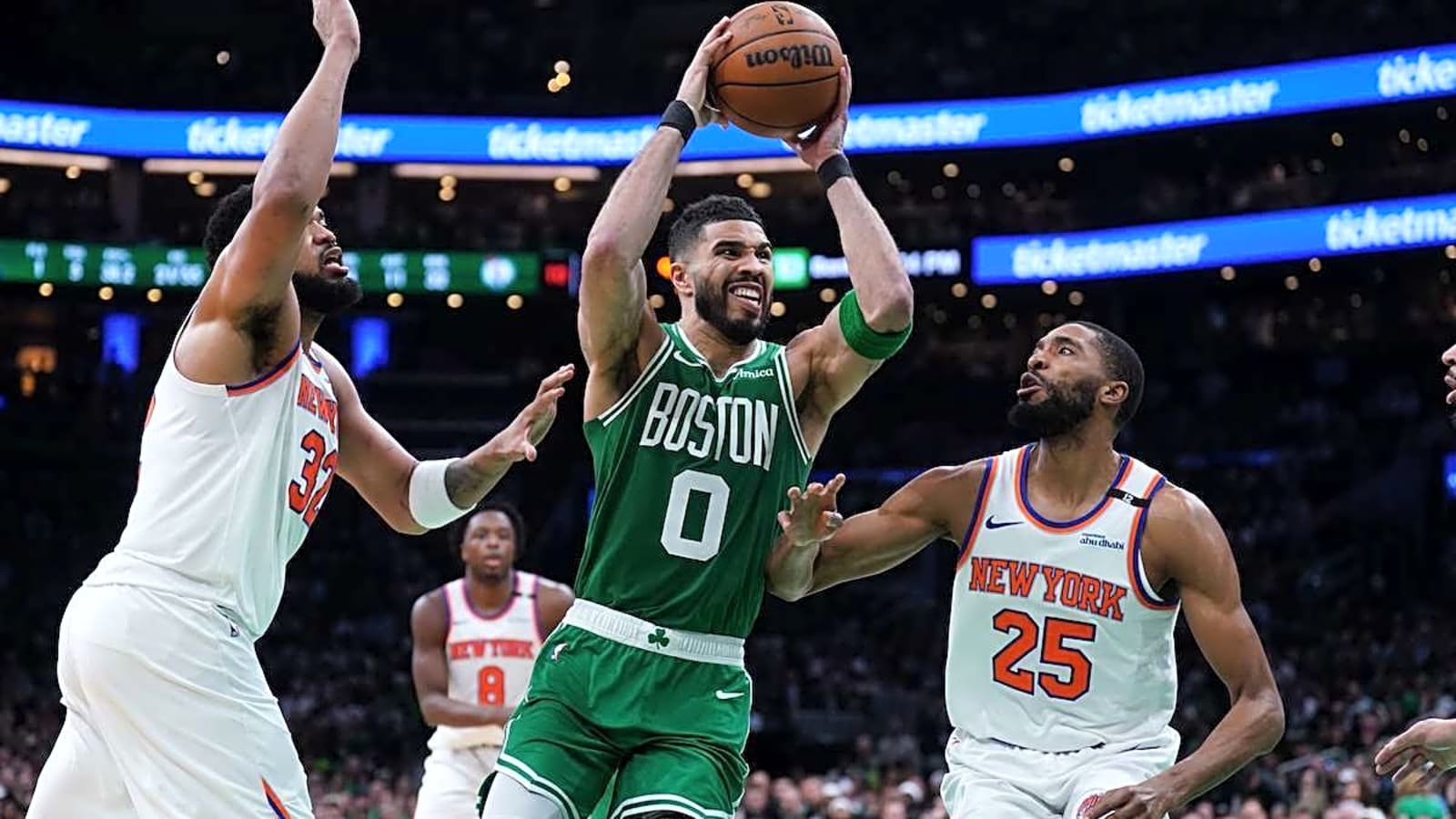
During the Boston Celtics’ first-round win over the Orlando Magic, Jayson Tatum carved up an elite Orlando defense, adjusting after a poor Game 1. Boston’s offense, fueled by Tatum, should’ve had an easier time against a New York Knicks defense that’s inferior to Orlando’s by any regular season statistical measure. But the Celtics find themselves in a 0-2 hole, largely stemming from Tatum’s struggles.
Tatum decimated the Knicks in the regular season, averaging an efficient 33.5 points (69.1 percent true shooting) and seven assists in their four matchups. That same, once-porous New York defense has flummoxed Tatum through two second-round games. In Boston’s two improbable losses, Tatum averaged 18 points and 5.5 assists (39.2 percent true shooting), struggling to create and score efficiently.
Some of Tatum’s struggles result from unfortunate shooting luck — he’s just 6-of-33 on shots away from the rim in the series so far. We can, however, attribute a bulk of Tatum’s rough start to New York’s shrewd defensive game plan, which remedied some of the mistakes Orlando made in the first round.
What The Knicks Are Doing Differently Than Orlando
Against Orlando, Tatum picked apart an excellent defense by targeting favorable matchups in space. The Magic took away Boston’s vaunted 3-ball, forcing the Celtics to live inside the arc. This approach benefited Tatum, who attacked switches without fear of help defenders muddying driving lanes.
Tatum attempted 25 percent of his shots at the hoop against Orlando, converting a scorching 78 percent of them, and drew shooting fouls on 13.7 percent of his shots. He’s not driving nearly as effectively against New York so far, posting a 20 percent rim frequency (5-of-7 shooting) and drawing shooting fouls on 8.7 percent of his field goals. That’s led to a significant dip in his free-throw rate from the first round (.482 vs. .214).
As strong as its defense plays, Orlando doesn’t have New York’s arsenal of sturdy wing defenders. The Knicks constructed their roster to beat Boston, sicing OG Anunoby, Mikal Bridges and Josh Hart at Tatum (and Jaylen Brown, who’s also struggled mightily). It’s much more challenging for Tatum to bully New York’s wings, which forces him to rely on a mediocre handle.
Like Orlando, the Knicks are frequently mixing in switches when defending Tatum. New York has diverted from Orlando’s strategy by shading heavy help, conceding 3-point jumpers instead of clean drives. Even when Tatum beat his primary defender in Games 1 and 2, there were always extra defenders swooping in to contest shots and force turnovers.
Jayson Tatum’s second round struggles largely stem from New York’s great wing defenders and aggressive gap help.
They’re shrinking the floor when Tatum catches, throwing extra hands and bodies in his path to make his life difficult on drives. pic.twitter.com/MdqJKz5fib
— Sportscasting NBA (@SportcastingNBA) May 9, 2025
New York’s intention to limit Tatum’s drives has proven extremely effective so far. He’s averaging 11.5 drives per game against the Knicks after logging 13.3 during the first round. His efficiency on drives has plummeted from 45.2 percent shooting with a 5.7 percent turnover rate against Orlando to 26.7 percent shooting with an 8.7 percent turnover rate (and zero assists) against the Knicks.
Neutralizing Tatum’s slashing has cratered his dangerous playmaking and sunk the Celtics’ collective offensive flow, as they rely on him to create coveted drive-and-kick opportunities. Despite New York’s willingness to help off of shooters, pressuring Tatum’s shaky handle limits his ability to fire accurate passes to cutters and floor-spacers.
Most of his 11 assists in the series result from transition opportunities or broken play situations. Even Tatum’s few half-court dimes didn’t come easy, as New York’s ball pressure and clogging of passing lanes made routine passes difficult. Note how hard Tatum and the Celtics had to work to convert these assists:
tough tatum assists pic.twitter.com/gP97GrsIHD
— bjpfclips (@bjpfclips) May 9, 2025
How Tatum And The Celtics Can Adjust
On two of Tatum’s 2-point makes in the series, Boston moved him off the ball and he benefited from motion and screening to free him. Targeting New York’s big men with off-ball screens complicates its switching intentions, which springs him loose downhill. Tatum can find favorable matchups after setting a screen himself, bypassing the driving phase entirely with seals at the basket.
tatum offball scoring pic.twitter.com/Du4cNrsWRM
— bjpfclips (@bjpfclips) May 9, 2025
New York’s constant pressure has led to hesitation from Tatum at times. In the few moments when he did attack decisively, positive results ensued. Indecision and hesitation have plagued Boston’s offense as a whole, not only Tatum. When Tatum initiates the offense before New York can set up help, he has a much easier time breaking its shell.
tatum decisive attacking pic.twitter.com/iHcpCyPRhs
— bjpfclips (@bjpfclips) May 9, 2025
Despite Tatum’s notable issues with a well-oiled Knicks defense, the Celtics are two massive blown leads away from leading the series 2-0. If Tatum’s shots fall at Madison Square Garden, such as upping his 25 percent 3-point clip, the Celtics may be able to regain control of the series without tweaking their approach.
Luck isn’t solely to blame for Boston and Tatum’s 3-point struggle. The Celtics have the tools to make their lives much easier by attacking the basket and diversifying their offensive approach. They won’t and shouldn’t abandon their deep-range shooting. A more balanced and simple offense will help facilitate their preferred offensive identity. It’ll create higher-quality for looks for Tatum and everyone else, and presumably get this formerly great offense back on track.
More must-reads:
- Germany defeats Turkey for EuroBasket gold; Dennis Schroder named MVP
- New Hall of Famer won't get his number retired by any team
- The 'NFL's three-passing TD game leaders' quiz
Breaking News
Trending News
Customize Your Newsletter
 +
+
Get the latest news and rumors, customized to your favorite sports and teams. Emailed daily. Always free!








